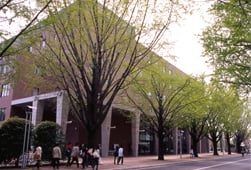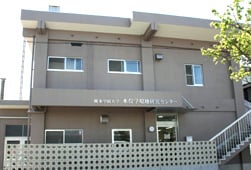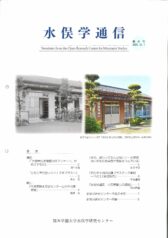On-campus and On-site Research Center for Minamata Studies
The Open Research Center for Minamata Studies is the base to promote “Minamata Studies” project, under which we explore the new academic discipline and methodology through clarifying the entire picture of the Minamata disaster, the “negative legacy”. In March 2005, the project was qualified as an Open Research Center Project for the Private Universities (with matching fund subsidy from the Ministry of Education, Culture, Sports, Science and Technology). Based on the two hubs, one on campus and the other in Minamata, we are engaged in the research of Minamata studies.
On-campus Research Center for Minamata Studies
 Located on Kumamoto Gakuen University campus in Oe, Kumamoto City, the On-campus Research Center is comprised of the office, the research room (at Bldg #14) and the archive (at Bldg #7). In partnership with Kumamoto Gakuen University Office of Academic Research and Educational Outreach, it serves as the head office of the center.
Located on Kumamoto Gakuen University campus in Oe, Kumamoto City, the On-campus Research Center is comprised of the office, the research room (at Bldg #14) and the archive (at Bldg #7). In partnership with Kumamoto Gakuen University Office of Academic Research and Educational Outreach, it serves as the head office of the center.
Every year, we organize “Minamata Studies Lectures” for students of all faculties as part of the regular course curriculum. At the graduate level, the social welfare and environmental course of the school of social welfare offers a unique curriculum with Minamata studies as one of the pillars.
On-site Research Center for Minamata Studies
 On-site Research Center for Minamata Studies was established in Minamata City on August 8, 2005, as an education and research base to connect the Open Research Center for Minamata Studies on Oe campus in Kumamoto City and Minamata the ground zero of pollution. While acting as the field base to promote our three projects, “Research on Health and Social Issues Concerning the Present Situations and Reevaluation of the Damages by Minamata Disease (Project 1)”, “Proposal of the Community Rehabilitation Model in Minamata and Ashikita Regions (Project 2)”, and “Data Acquisition, Database Creation, and Worldwide Dissemination of Materials Related to Minamata Studies (Project 3)”, the On-site Research Center also offers the consultation service on healthcare and welfare for all the residents along the Shiranui Sea coast affected by organic mercury.
On-site Research Center for Minamata Studies was established in Minamata City on August 8, 2005, as an education and research base to connect the Open Research Center for Minamata Studies on Oe campus in Kumamoto City and Minamata the ground zero of pollution. While acting as the field base to promote our three projects, “Research on Health and Social Issues Concerning the Present Situations and Reevaluation of the Damages by Minamata Disease (Project 1)”, “Proposal of the Community Rehabilitation Model in Minamata and Ashikita Regions (Project 2)”, and “Data Acquisition, Database Creation, and Worldwide Dissemination of Materials Related to Minamata Studies (Project 3)”, the On-site Research Center also offers the consultation service on healthcare and welfare for all the residents along the Shiranui Sea coast affected by organic mercury.
In addition, we have been organizing “open lectures” under various themes such as wellbeing, environment, life, and economy, calling for participation to a wide range of citizens. Furthermore, the On-site Research Center is beginning to function as a platform to explore the way the community should be in Minamata and Ashikita region. Aiming to question the human lifestyle, daily lives, and the ideal state of community (in terms of education, environment, welfare, economy, and politics) on the basis of the Minamata Disease case as a “negative legacy”, the “Strategic Community Platform of Minamata and Ashikita” was established in the On-site Research Center in May 2006 to provide “an arena for meeting, learning, discussing” among diverse people related to the Minamata issue such as citizens, NPO, researchers, local business, and government administrators, and “a stage to create new sets of values (lifestyle and culture)”. This Platform is open to all people who have long been living in Minamata and Ashikita region and confronting the damages and disaster of Minamata disease. The On-site Research Center aspires to serve as a lubricant for smooth horizontal connection among a wide variety of actors and sectors tackling local issues.
While functioning as a research base for the researchers and graduate students working for the Minamata Studies Projects of Kumamoto Gakuen University, the On-site Research Center is designed to be utilized as a facility widely open to the researchers in and out of Japan and a meeting place easily accessible to the local residents.
The On-site Research Center located in Hama-machi, Minamata City, resides in a place that used to be Wakakusa Nursery. The building, refurbished and offered on loan by Minamata City, is a two-storied, reinforced concrete structure with a total floor area of 300 m2. The first floor holds an exhibition space, a reading room, and a discussion space, and the second floor houses a consultation desk, a research room, and a meeting space. For the architecture/facility of the Center, best available consideration was made in the light of barrier-free and universal design by equipping it with a slope in the front entrance, flat floors, a new elevator, and infrared hearing aid system.







